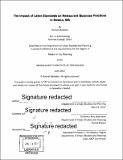| dc.contributor.advisor | Amy Glasmeier. | en_US |
| dc.contributor.author | Meketon, Rachel (Rachel Anne) | en_US |
| dc.contributor.other | Massachusetts Institute of Technology. Department of Urban Studies and Planning. | en_US |
| dc.coverage.spatial | n-us-ma | en_US |
| dc.date.accessioned | 2017-09-15T15:33:02Z | |
| dc.date.available | 2017-09-15T15:33:02Z | |
| dc.date.issued | 2017 | en_US |
| dc.identifier.uri | http://hdl.handle.net/1721.1/111412 | |
| dc.description | Thesis: M.C.P., Massachusetts Institute of Technology, Department of Urban Studies and Planning, 2017. | en_US |
| dc.description | "June 2017." Cataloged from PDF version of thesis. | en_US |
| dc.description | Includes bibliographical references (pages 59-65). | en_US |
| dc.description.abstract | My research seeks to understand the impact of labor standards, or labor regulations, on restaurant business practices. I replicated a survey of full-service restaurants in Boston that was originally administered by T. William Lester in the Research Triangle Park and San Francisco (2016). The survey asked restaurant employers how they recruit, retain, and compensate employees and, particularly, servers and cooks. I hypothesized that, following the theory of dynamic monopsony, wage variation and "high road" practices among restaurants in Boston, with middling labor standards, would fall somewhere between the Research Triangle, with no locally-enacted labor standards, and San Francisco, with the highest labor standards in the country. For servers, I found that wage variation in Boston was similar to the Research Triangle likely because both regions have a tipped minimum wage that is lower than the regular minimum wage. For cooks, the wage variation could not be explained by dynamic monopsony. At the time of study, Boston had the highest regular minimum wage, but it had more variation in wages and a much higher average wage than the other regions. My results can likely be explained by labor supply. A linear regression found that, at a 99% confidence level, restaurants that could easily hire cooks paid $2.33 more than restaurants that had difficulty hiring cooks, which suggests that some restaurants offer higher wages to fill positions and retain workers. I also found that a substantial portion of restaurants (40%) follow high road practices, but there are discrepancies between my data and a recent survey of Boston area restaurant employees (Reyes and Rodriguez 2016a). Ultimately, I recommend that the City of Boston or an appropriate intermediary craft a career ladder strategy for current restaurant workers and city residents in collaboration with local businesses that ensures that the businesses will offer high quality jobs to newly-trained employees. | en_US |
| dc.description.statementofresponsibility | by Rachel Meketon. | en_US |
| dc.format.extent | 72 pages | en_US |
| dc.language.iso | eng | en_US |
| dc.publisher | Massachusetts Institute of Technology | en_US |
| dc.rights | MIT theses are protected by copyright. They may be viewed, downloaded, or printed from this source but further reproduction or distribution in any format is prohibited without written permission. | en_US |
| dc.rights.uri | http://dspace.mit.edu/handle/1721.1/7582 | en_US |
| dc.subject | Urban Studies and Planning. | en_US |
| dc.title | The impact of labor standards on restaurant business practices in Boston, MA | en_US |
| dc.type | Thesis | en_US |
| dc.description.degree | M.C.P. | en_US |
| dc.contributor.department | Massachusetts Institute of Technology. Department of Urban Studies and Planning | |
| dc.identifier.oclc | 1003292083 | en_US |
